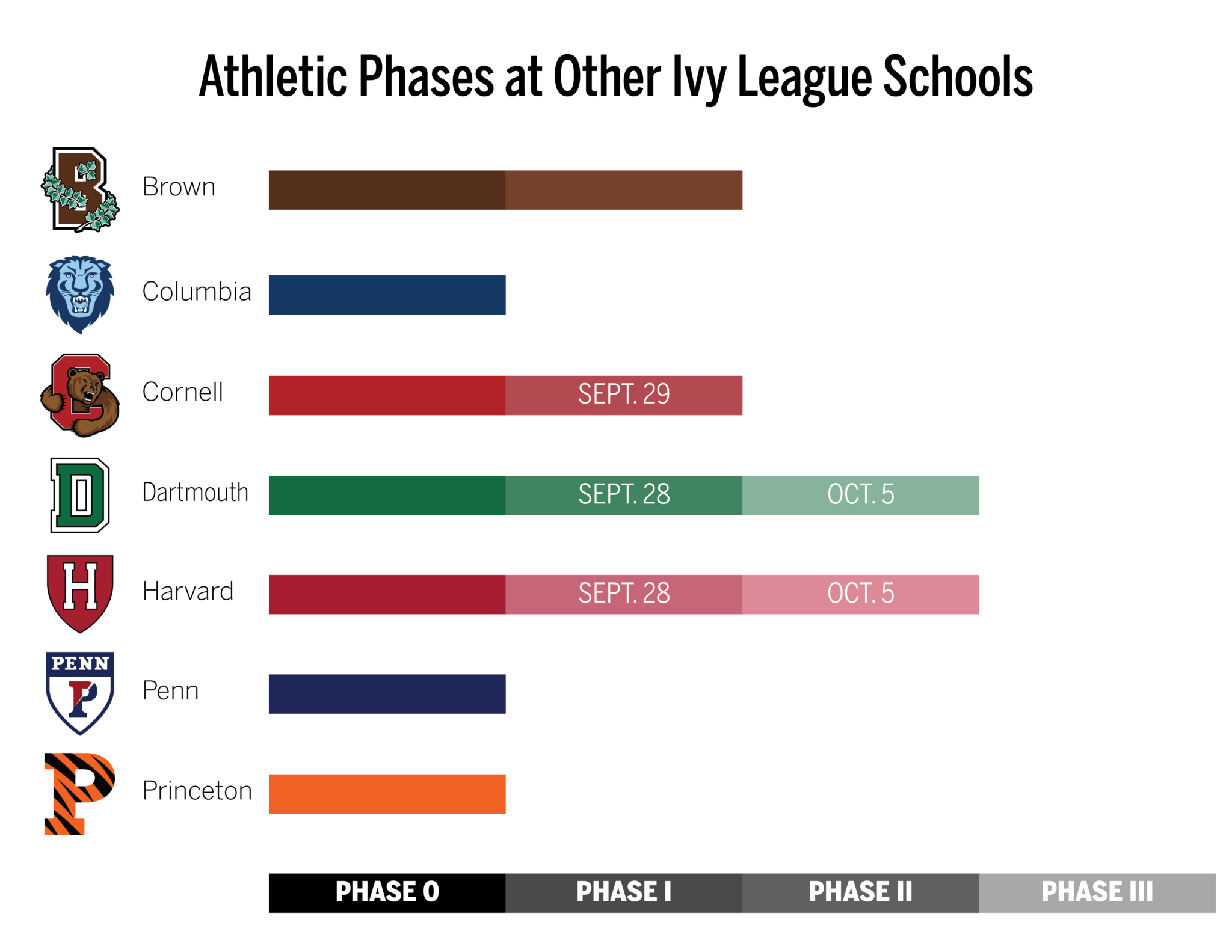Yale Athletics reverted to Phase 0 Tuesday. Where do the other Ivies stand?
Harvard and Dartmouth are in Phase II, while Brown and Cornell currently occupy Phase I. Yale joins Columbia, Penn and Princeton in Phase 0.

Isabella Huang, Production & Design Editor
Prior to the Ivy League’s decision last March to cancel the spring sports season, Ancient Eight athletic programs focused on defeating each other on fields, courts and more. Now, their goal is simply returning there.
Last Wednesday, Yale teams entered Phase II of the three-tiered Ivy League plan to resume athletic activities before the Bulldogs returned to Phase 0 Tuesday evening after the emergence of a COVID-19 cluster within the Yale men’s hockey team.
While the Ivy League phasing framework is uniform throughout the conference, each Ivy school advances — and regresses — through phases at its own discretion. Although no teams have reached Phase III, two schools — Harvard and Dartmouth — are actively in Phase II, while some with almost entirely remote enrollment this fall have yet to move past Phase 0.

Here’s where every school around the Ancient Eight stands:
Phase 0
This phase does not permit any in-person athletic activities. Prior to Yale reverting back to Phase 0 Tuesday night, only schools that had barred the large majority of undergraduate students from returning to campus for the fall semester remained in Phase 0: Columbia, Penn and Princeton.
“Since we have no students on campus, there is no [phasing-in] of any athletic activity nor will there be for the entirety of [the] fall semester,” Penn’s Director of Athletic Communications Mike Mahoney told the News.

Similarly, Princeton has the large majority of their undergraduate population learning remotely and have not begun reopening athletic facilities. Student-athletes are, however, meeting virtually with their teams in accordance with NCAA and Ivy League guidelines.
While Columbia Athletics declined to comment, women’s tennis player Tatiana Ziff ’24 shared that she and other Lions are in a similar position because Columbia is also fully remote this semester.
“Basically right now Columbia is fully remote, and that includes athletics,” Ziff said. “They were about to open the gym to student-athletes … [but] that has been postponed for two weeks, so we are waiting on that. Besides that, we do not have access to any other athletic facilities.”

Phase I
Phase I allows for a maximum of one hour per day of strength and conditioning training, as long as social distancing guidelines are followed. Furthermore, individual meetings with coaches are permissible. Two members of the Ancient Eight are currently in Phase I: Brown and Cornell.
Christopher Humm, the director of athletic communications at Brown, told the News that strength and conditioning practice has resumed in Providence, noting that regulations vary across varsity teams in and out of season.
“The University will make a decision to advance to Phase II when it determines that it’s safe for the entire Brown community to move forward,” Humm added.
In Ithaca, the Big Red have moved past Phase 0 and began Phase I on Sept. 29, according to The Cornell Daily Sun. Cornell Athletics did not respond to requests for comment on when the University plans to transition into Phase II.
Phase II
Unlike the preceding stages, Phase II allows for sport-specific training, and the maximum practice time also doubles to two hours a day. In-person meetings of up to 10 people are also acceptable under the guidelines.
Besides Yale, which reached Phase II on Oct. 7 before reverting back to Phase 0 on Oct. 13, Harvard and Dartmouth are the only two other Ivy Leagues to have reached Phase II. The Crimson and the Big Green remain actively in Phase II as of now.
The Harvard Crimson reported that the school began Phase II on Oct. 5, exactly one week after the Crimson started Phase I on Sept. 28.
Dartmouth’s Director of Varsity Athletics Communications Rick Bender detailed a similar timeline for the Big Green.
“The Dartmouth Athletics Reopening Task Force has been working diligently since March to return our student-athletes to some level of athletic activity in accordance with Ivy League and College policy as well as state and federal guidelines,” he said. “We were able to begin Phase I activity in late September after successfully completing the College quarantine period. Programs began transitioning to Phase II after satisfying our internal criteria for Phase I.”
“Right now we are excited that we have been able to resume any level of skill instruction and sport-related activity,” added Bender.
Volleyball player Ellie Blain ’24 told the News that Dartmouth entered Phase I on Sept. 28 and entered Phase II on Oct. 5.

Phase III
Although no one in the Ancient Eight has reached this final tier, Phase III would mark the beginning of mid-sized group activities. The allotted practice time increases to 12 hours per week, and the biggest change from earlier stages is that Phase III allows for an ambiguous increase in practice group size as permitted by campus policies.
Some schools may not reach the phase this fall. Although Harvard Athletics did not return the News’ requests for comment, spokesperson Tim Williamson told the Crimson earlier this month that he doubts the school will reach Phase III because increased group capacity and the relaxation of social distancing measures would run counter to Harvard policies.
Up north at Dartmouth, Bender said the decision to transition into Phase III will need to come in consultation with the broader college leadership.
The Ivy League has not yet announced a decision on the status of spring-semester athletic competition.
James Richardson | james.richardson@yale.edu







